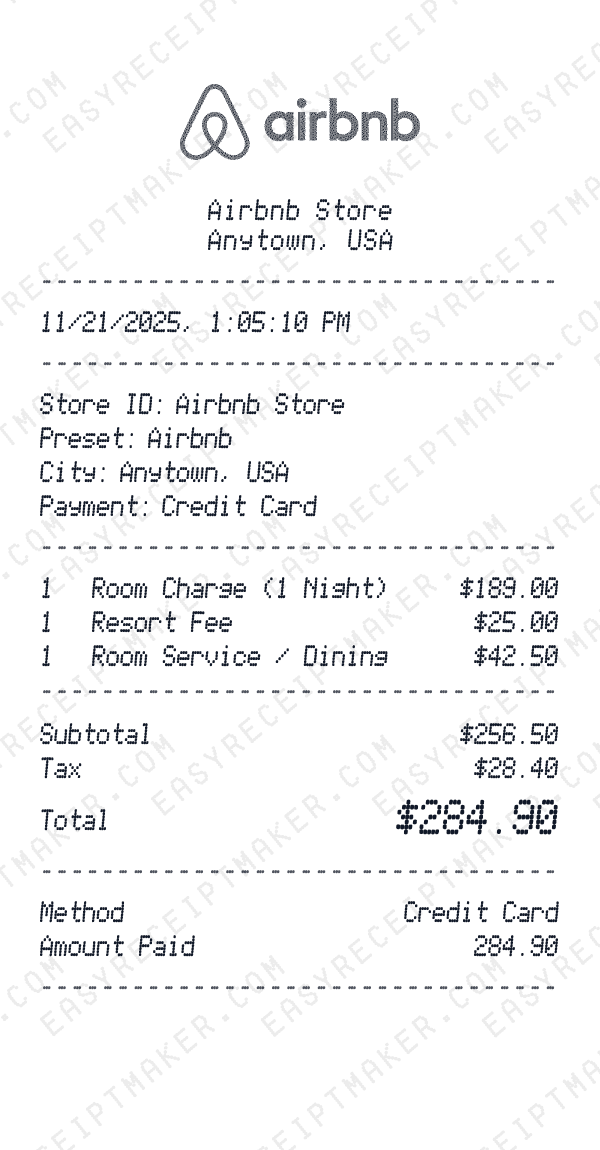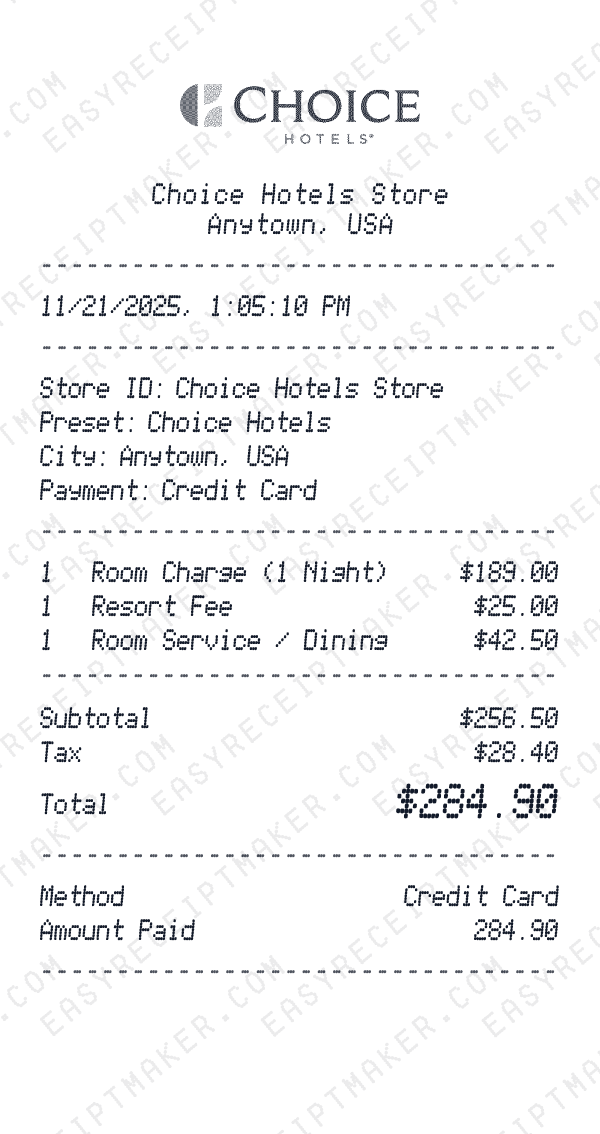Replace your lost hotel receipt
Did you lose your hotel receipt or folio after checkout? Whether you left it at the front desk, never received an email confirmation, or it got mixed up with other travel documents, missing hotel receipts can delay expense reimbursements and complicate travel deduction claims. Our hotel receipt generator helps you reconstruct the stay for your records with all essential details: hotel name and location, check-in and check-out dates, room type, nightly rate, number of nights, taxes, resort fees, and payment method. The generated receipt mirrors the detailed format of real hotel folios, making it suitable for corporate expense systems and IRS documentation.
Hotel receipts are critical for business travelers who need to substantiate lodging expenses. When you need to reconstruct a hotel stay, the IRS Cohan Rule allows you to estimate lodging expenses when original records are unavailable, as long as you have supporting evidence like credit card charges, conference registrations, flight itineraries, or calendar appointments showing the business trip. This receipt generator helps you produce professional documentation that pairs with your bank statements and travel logs to complete your expense trail.
How to generate a hotel receipt
Start by entering the hotel name, address, and contact information. If you stayed at a major chain like Marriott, Hilton, Hyatt, or Holiday Inn, the tool can auto-fill branding and typical formatting. For boutique or independent hotels, enter the details manually. Next, add your check-in and check-out dates—these should align with your flight bookings, conference schedule, or client meeting calendar if the trip was business-related.
Now enter the room details. Select the room type (standard, deluxe, suite, etc.) and the nightly rate. Enter the number of nights stayed, and the tool will calculate the room subtotal automatically. Add applicable taxes—hotel taxes vary widely by city and state, typically ranging from 8% to 20% depending on local occupancy taxes, tourism fees, and state sales tax. Include any resort fees, parking charges, Wi-Fi fees, or incidental charges (room service, minibar, etc.) if applicable. Enter the total amount and payment method (credit card, company card, or direct billing), then download your hotel receipt as a high-resolution image. Attach it to your expense report along with your credit card statement and a summary of the trip's business purpose.
Why hotel receipts are essential for travel expense reimbursement
Lodging is one of the largest components of business travel expenses, and the IRS requires detailed documentation for all hotel stays. A credit card statement showing a charge from a hotel is not sufficient—you need an itemized receipt (called a folio) that breaks down the nightly rate, number of nights, taxes, fees, and any additional charges. This level of detail is necessary to prove the stay was business-related and to defend the expense during an audit.
Corporate travel policies are equally rigorous. Finance teams need to verify that hotel stays align with approved business trips, conference attendance, or client site visits. A reconstructed hotel receipt with specific check-in and check-out dates makes it easy to cross-reference with flight bookings, meeting agendas, and project timelines. When your receipt shows a three-night stay at a hotel near your client's headquarters during the same week as a logged project kickoff meeting, approvers can quickly validate the expense and process your reimbursement. Without a detailed folio, your claim may be flagged for additional review or denied until you provide proper documentation.
Common reasons hotel receipts go missing
Many travelers lose hotel receipts during checkout. You're rushing to catch a flight, juggling luggage and coffee, and you forget to grab the printed folio from the front desk. Or the hotel promises to email your receipt, but it never arrives due to incorrect email addresses, spam filters, or system glitches. Some hotels only provide electronic receipts through their mobile apps, and if you switch phones or delete the app months later, accessing past folios becomes difficult or impossible.
Another common problem: group bookings or corporate travel accounts. If your company books hotels through a travel management system or corporate account, individual folios may not be sent directly to you. Instead, they go to a central travel coordinator or are only accessible through the booking platform's portal—which you may not have access to after your trip ends. Reconstructing your own hotel receipt with accurate dates, rates, and charges speeds up the reimbursement process and keeps your travel documentation complete.
Tips for accurate hotel receipt reconstruction
To reconstruct hotel receipts accurately, start with your credit card or bank statement. The statement shows the exact charge amount and transaction date, which serves as the foundation for your reconstruction. Next, check your email and travel booking confirmations for the hotel name, address, and reservation details. If you booked through Expedia, Booking.com, or your company's travel portal, those platforms often retain basic booking information even if the final receipt was never sent.
When estimating the nightly rate and fees, refer to the hotel's current rate card or use booking sites to see typical prices for the room type and dates you stayed. Remember to account for seasonal pricing—rates during conferences, holidays, and peak tourist seasons are significantly higher than off-peak rates. Add local hotel taxes based on your city's occupancy tax rate (you can usually find this with a quick web search). If your reconstructed total matches your credit card charge exactly or within a few dollars, your documentation is solid. Attach your bank statement, flight itinerary, and conference registration to your reconstructed hotel receipt to provide the full context finance teams and auditors need to approve your lodging expense confidently.







